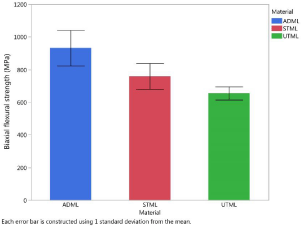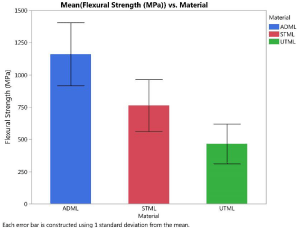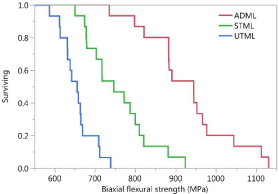
Research Article
J Dent & Oral Disord. 2020; 6(1): 1124.
Mechanical Properties of Translucent Multilayered Dental Zirconia
Paek T1, Fan Y2* and Giordano R2
¹Department of Dentistry, Boston University Henry M. Goldman School of Dental Medicine, USA
²Department of Restorative Sciences & Biomaterials, Boston University Henry M. Goldman School of Dental Medicine, USA
*Corresponding author: Yuwei Fan, Department of Restorative Sciences & Biomaterials, Boston University Henry M. Goldman School of Dental Medicine, Boston, Massachusetts, USA
Received: January 30, 2020; Accepted: February 18, 2020; Published: February 25, 2020
Abstract
High translucent zirconia with a chroma multilayer has been used in dentistry recently to improve the esthetical match to natural teeth to mimic the enaml to cervical gradation in color. However, there are concerns about the layers effects on the strength as well as effects of higher yittria content. This study evaluated the biaxial flexural strengths and 3-point bend flexural strengths of three different types of commercially available zirconia. The higher yttria cotent, more translucenct zirconia resulted in decreased the biaxial flexural strength and 3-point bend flexural strength.
Introduction
Pure zirconia has limited use due to the destructive monoclinic to tetragonal martensitic phase transformation. Yttria-Stabilized Tetragonal Zirconia (YTZP) make the tetragonal phase partially stabilized at room temperature and therefore, has become a widely used restorative material for fixed restorations in recent decades [1]. Original YTZP formulations were based on 3-5 mol % yttria and 1% alumina, which produced a high strength, but high opacity. New formulations have increased yttria to about 7 mol % and decreased alumina to about 0.25%. Making seemingly small changes, manufacturers have been able to produce a more translucent dental material. Typically, the higher the yttria content and sintering temperature is, the greater the cubic content and translucency of the material [2]. However, there is a tradeoff since this also potentially produces a lower strength and lower toughness [3], although some previous reports indicated no significant decrease of flexural strength in certain translucent zirconia such as Zpex [4].
In pursuit of a more esthetic material, the multi-layered zirconia intends to imitate the shade gradient observed in natural teeth. The natural gradient is most translucent at the incisal edge, fading into a more chromatic and opaque cervical region. Katana (Kuraray Noritake, Japan) was the first to release a multi-layered zirconia system in February 2015, including three translucent shades: A-Dark Multi-Layered (ADML), Super Translucent Multi-Layered (STML), and Ultra Translucent Multi-Layered (UTML). According to the manufacturer, the esthetic and mechanical properties of this product can be used throughout the mouth as a monolithic indirect restoration [5].
With many new products entering the market, it is crucial to test the material in the lab before using them in the clinic in orther to verify product claims and make informed decisions about clinical use. Katana applied the shade gradient concept to zirconia in order to elevate the esthetics. In order to test the mechanical properties of translucent zirconias, the varying translucencies within each product must be accounted for.
Methods
Forty-five sectioned disks of ADML A-Dark Multilayered zirconia (Lot number: DSLAP) (conventional, n=15), STML Super Translucent Multilayered zirconia (Lot number: DSBYZ) (intermediate translucency, n=15), and UTML Ultra Translucent Multilayered zirconia (Lot number: DRSAA) (high translucency, n=15) zirconia were prepared by core-drilling cylinders from a large 90 mm disc (Kuraray Noritake Dental Inc.).
Forty-four sectioned bars of ADML, STML, and UTML zirconia were prepared by sectioning bars from the remaining disks. The zirconia cylinders with a diameter of 20.4 mm were core drilled using a water cooled diamond drill bit through the chroma layers of the the zirconia puck, and was attached to a mandrel with epoxy cement. After the cement hardened, the cylinders were sectioned into disks, 1.9 mm in thickness, using an IsoMet 5000 Linear Precision Saw (Buehler Ltd, Lake Bluff IL). The diamond blade speed was set at 3000 rpm and feed rate was 5.0 min/min in order to section the disks effectively without fracturing the pre-sintered zirconia. The sectioned disks were then placed on a bed of ZrO2 beads to prevent them from fusing with the dish. The disks were sintered according to the manufacturer’s recommendations. The sintering was completed in a high temperature furnace Zircar Hot Spot 110 (Zircar Zirconia Inc) with a slow firing cycle ramping from room temperature to 1500°C in 2.25 hours, soaked for 4.5 hours, then cooled to 90°C in 2.25 hours. The sectioned specimens were prepared to compensate for 20% shrinkage in order to get the desired fully-sintered dimensions of 1.5 mm thickness and 16.3 mm in diameter and bar dimensions of 2×3.5×15 mm. The disks were tested in a ball-on-three-ball fixture according to ISO 6872 [6] and NPL guideline on biaxial flexural strength [7] and the bars were tested in 3-point bend flexural fixture using a universal testing machine Instron 5566A until complete fracture, with failure recorded at max load (MPa). Data was analyzed with ANOVA and Tukey HSD using JMP Pro 13 with a significant level of a=0.05. The grain size was measured on 200 grains from SEM image using image J.
Results
Statistical analysis was performed using JMP Pro 13 software. Data were analyzed using one way ANOVA and post hoc Tukey test, and Weibull distribution analysis.
The mean biaxial flexural strengths for ADML, STML, and UTML decreased as the translucency of the zirconia material increased, as shown in Table 1 and Figure 1. The mean 3-point bend flexural strengths for ADML, STML, and UTML decreased as the translucency of the zirconia material increased as shown in Table 2 and Figure 2. ADML had significantly higher biaxial flexural strength and 3-point bend flexural strength than others. UTML had the significantly lower biaxial flexural strength and 3-point bend flexural strength than others. Figure 3 shows the survival plot of biaxial flexural strength of each zirconia material. Higher translucent zirconia shows significant lower survival rate.

Figure 1: Bar chart of biaxial flexural strength of tested translucent zirconia.
Each error bar is constructed using 1 standard deviation from the mean.

Figure 2: Bar chart of 3-point bend flexural strengths of tested translucent
zirconia.
Material
N
Mean ± Std Dev
CV
Sig.*
Weibull Modulus
ADML
15
931.76 ± 108.94
11.7
A
9.33
STML
15
758.01 ± 80.00
10.6
B
9.85
UTML
15
654.92 ± 40.78
6.23
C
16.47
Table 1: Mean biaxial flexural strength of tested zirconia translucencies.
Material
N
Mean ± Std Dev
CV
Sig.
Weibull Modulus
ADML
14
1159.72 ± 244.16
21.1
A
6.19
STML
15
762.16 ± 200.96
26.4
B
4.1
UTML
15
464.28 ± 153.86
33.1
C
3.75
Table 2: 3-point bend flexural strengths of tested translucent zirconia (MPa).
The mean grain sizes of ADML, STML, and UTML as shown in Table 3 are 5.19 ± 1.23 μm, 10.88 ± 4.01 μm, and 28.33 ± 9.08 μm, respectively. UTML had significantly higher grain size than others. ADML had significantly lower grain size than others. The secondary electron SEM images of the typical zirconia surface in Figure 4 shows different grain morphology. Translucent zirconia has much larger grain sizes. The EDS (energy dispersive spectrophotometry) analysis shows ADML, STML, and UTML have 3.22 ± 0.08, 4.83 ± 0.13, and 5.3 ± 0.07 wt. % Y2O3, respectively. All of those types of zirconia have 1.14 ± 0.06 wt. % HfO2 as well. No significant composition changes are observed between enamel and body shade layers.
Material
Mean
Std Dev
CV
Min
Max
Range
IRQ
ADML
5.191
1.23
23.69
2.572
9.526
6.954
1.647
STML
10.88
4.005
36.82
3.679
24.57
20.888
5.62
UTML
28.33
9.076
32.03
7.083
62.74
55.661
12.243
Table 3: Mean grain size (μm) of tested zirconia materials.
Discussion
Figure 3 shows the survival of each of the specimen within the variable group by plotting the biaxial flexural strength by maximum load of each group. It is evident that the Ultra Translucent group had a lower maximum load; however, the maximum load values are more consistent within the group. In contrast, the A-Dark material had the highest average maximum load, but had the largest discrepancy of maximum load values.

Figure 3: Survival plot of biaxial flexural strength of each zirconia material.

Figure 41: Secondary electron SEM images of zirconia surface after sintering.
(A) ADML (B)STML (C) UTML at 10,000× magnification and (D) (C) UTML at
5000× magnification. Scale bar on (A)-(C) is 2 μm, and (D) is 4 μm.
Tetragonal partially stabilized zirconia is a desirable material due to its high fracture toughness over 3 MPa.m1/2. The material has the ability to undergo a phase transformation from tetragonal to monoclinic under high stress to stop the propagation of cracks. There are three crystalline forms of zirconia: monoclinic, tetragonal, and cubic. If a sufficient amount of the tetragonal phase is available, then a phase transformation from the tetragonal phase to the monoclinic phase will occur. In this transformation, a volume expansion transpires, compressing and retarding the growth of the crack. This property is also known as transformation toughening. However, with the increased content of yttria in the zirconia ceramics over 4 mol% the metastablized tetragonal zirconia phase (t) may become to untransformable tetragonal phase (t’). The t’ phase is much stable at room temperature and cannot be transformed to m-zirconia under high stress [8]. Under a higher yttria content in UTML, the cubic phase (c) zirconia is more stable and becomes dominate phase at the room temperature. Therefore, the zirconia with higher yttria content has shown a lower flexural strength.
Weibull Modulus is a dimensionless parameter of the Weibull distribution which is used to describe variability in measured material strength of brittle materials. In this study, the Weibull modulus in the biaxial flexural strength tested groups are higher than 8, which indicate all three types of zirconia have acceptable good robustness and reliability. Three point bend bars test showed a lower Weibull modulus which is likely due to the small specimen dimension size used in this study. Also, the testing rectangular bars were not highly polished and may have edge defects. Larger sized bars and polished edges might provide a higher Weibull Modulus.
Conclusion
Zirconia materials with higher translucency and yttria content showed a decrease in the biaxial and 3-point bend flexural strength. The clinical application of higher translucency zirconia as a dental prosthesis should be carefully considered due to lower flexural strength values.
Acknowledgement
This study did not receive any specific grant from funding agencies in the public, commercial, or not-for-profit sectors. The authors appreciate the gift of zirconia material from Kuraray Noritake Dental Inc.
References
- Chevalier J. What future for zirconia as a biomaterial?. Biomaterials. 2006; 27: 535-43.
- Zhang Y. Making yttria-stabilized tetragonal zirconia translucent. Dent Mater. 2014; 30: 1195-203.
- Todd D. Church, Jeffrey P. Jessup, Villa L. Guillory, et al. Translucency and strength of high-translucency monolithic zirconium oxide materials. General Dentistry. 2017: 48-52.
- Matsuzaki F, Sekine H, Honma S, Takanashi T, Furuya K, Yajima Y, et al. Translucency and flexural strength of monolithic translucent zirconia and porcelain-layered zirconia. Dent Mater J. 2015; 34: 910-907.
- Zhang Y, Lawn BR. Novel zirconia materials in dentistry. J Dent Res. 2018; 97: 140-147.
- ISO 6872 Flexural Strength Testing of Dental Ceramics. 2015.
- Roger Morrell. Biaxial Flexural Strength Testing of Ceramic Materials, A national measurement good practice guide No. 12. Updated Dec 2007. HMSO and Queen’s Printer for Scotland. 2007.
- Dusan Bucevac, Tomaz Kosmac, Andraz, Kocjan. The influence of yttriumsegregation- dependent phase partitioning and residual stresses on the aging and fracture behaviour of 3Y-TZP ceramics, Acta Biomaterialia. 2017; 62: 306-16.